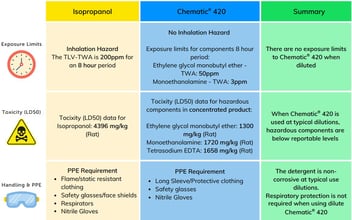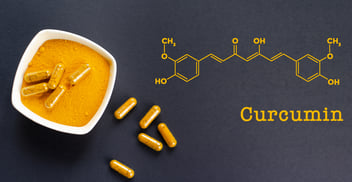CCE Journey: How We Select The Optimal Cleaning Detergent
Our method of detergent selection and its importance is something that can affect the production process. Dober does not just pick out a random detergent from our product line and send it to the customers, hoping it will work. Extensive thought and testing go into selecting the right product for our clients. We go on a journey to recommend a detergent, that is not only the most effective for cleaning, but the one that will reduce cleaning time, save money, and keep operators safe.
How We Select Detergents
Temperature Capabilities
While we have many criteria as to how we select cleaning agents for customers, the one that can cause the most issues is temperature. Customers’ temperature and equipment capabilities are important attributes when we consider detergent performance. If a client does not have heat capabilities or does not have the ability to maintain heat, the detergent, if chosen correctly, will still clean, but it may take additional steps or increased action. Chematic critical cleaning agents are designed to work at typical use concentrations and ideal temperatures for the soils in order to prevent foaming. Our detergents are formulated with raw materials that are designed to break down certain residues, trap insolubles and keep them suspended in solution. Our detergents perform best at or above their cloud points - the temperature where surfactants are released from the formula clouding the solution. Foam generation is the least when at or above the cloud point and it is worse when below the cloud point. This means, not only will cleaning performance be optimized, but higher temperatures will help decrease foam creation. If customers are using fill and soak, scrub/wipes, or power washers, then foam is not necessarily an issue if the detergent is used with little to no heat. The problems with foam come more so from when a cleaning process is scaled up. Excessive foam generation is often observed during scale-up with the increased action associated with automated cleaning processes, coupled with the inability to obtain or maintain heat. This can affect equipment function and make a mess by creating foam that can fill equipment and leak onto the floor.
pH Levels
One way we select our detergents is by pH range. pH may be evaluated because of the type of soil being cleaned, waste stream restrictions, or employee safety concerns. Dober offers cleaning agents that span all pH ranges, from acidic to highly alkaline with mild/moderately alkaline pH in between. Our studies have shown that cosmetic and personal care products are cleaned more effectively with moderately alkaline detergents, while polymer coatings are more effectively cleaned with moderately alkaline or acidic detergents, depending on polymer base chemistry.
Another important aspect that we take into consideration when selecting a detergent is the type of waste stream a customer has. Some facilities’ waste streams can only handle a certain pH range based on regulations or other chemicals being put down the drain. If a company does not have the ability to handle multiple waste streams or to neutralize multiple streams into a pit, we select the pH that meets those requirements, even if it is not the most effective detergent.
Lastly, detergent pH is an important consideration from the standpoint of operator safety. Depending on the type of equipment and cleaning process used, operators may be exposed to detergent frequently. If companies can only scrub/wipe or power wash their materials, operators may be exposed to the harshness of the chemicals in the detergent. Highly acidic or alkaline detergents can burn skin or clothes and pose a threat if a large quantity is spilled undiluted onto the floor or other surfaces. For this reason, we also select detergents based on the amount of exposure one might have to the detergent.
Soils
The biggest factor in how we select the right detergent is the soil. Knowing, not just the base of the soil, but also the key components, allows us to select a variety of cleaning agents to evaluate. We have a line of detergents that are designed for a variety of polymer coatings. For example, we have Chematic® NE/NM, Chematic® RL/RS, and Chematic® L/S Plus which we use to clean the polymers Eudragit® NE 30 D, NE 40 D, and NM 30 D, the Enteric Eudragit® Series, and Eudragit® RL & RS formulations respectively. Each detergent is also designed to be able to clean most of the key components in these formulations such as talc, plasticizers, or pigments. Another example is Chematic® 422, which mainly cleans products such as Opadry® coatings, and Enteric coatings with high pigment, and insolubles, being the best at cleaning talc, TEC, and pigment.
We also have many choices for cosmetic and personal care soils. Each detergent is within the same pH range, but can also clean other soils of components of these areas. These detergents include Chematic® 630, Chematic® 8700, Chematic® 640, and Chematic® 670. While cosmetics and personal care items may be the main soils for which these detergents are used, they all also have specialties. Chematic® 630 cleans pigment and oils well which are key components in many cosmetics and personal care items or stand-alone items. Chematic® 640 and 670 are useful with gels and can be used separately or in conjunction with each other. Chematic® 8700 is also effective in cleaning products containing a variety of oils & grease.
When it comes to selecting the right detergent, it's easy most of the time, as we have designed many of our detergents for specific types of products. However, there have been times when we are posed with a challenging soil and then we choose the detergents that we believe fit the soil the best. This is called a “Detergent Screening” or “Selecting the Optimal Detergent” where we choose 3 to 4 of the best options and try to clean the soil with all the same parameters that replicate customer capabilities to see which performs the best. The knowledge from this testing will be used to select the most effective detergent to continue testing with. Our area of expertise is to develop cleaning solutions for even the most difficult-to-clean soils and residues.
Why Is Using the Right Detergent Important?
Quantity of Product & Cost Savings
For many companies right now, the detergent they currently have requires many steps at lower concentrations (for safety reasons) to get a quality clean. However, most of the time this means that the detergent they're using is not the correct one for their soil. We give the ability to clean in minimal steps and in less time with a slight concentration boost.
It's important to find the right detergent to avoid the need for overbuying of product. This can give companies cost savings to purchase the correct detergent and validate it for their facility. If the correct detergent and concentration are chosen for a soil, cleaning multiple/heavy layers or soils with a long dirty hold time (DHT) should not be an issue.
Cleaning Time & Effort
One of the biggest positives to choosing the right detergent is how it will affect a company cleaning time and effort. From our experience, one of the most important goals of our clients is to reduce these two factors. If the incorrect detergent is used, cleaning times and steps will need to be extended. This can cause production to shut down longer than needed just to clean the equipment.
Once the proper detergent is recommended, cleaning times and steps can be dramatically reduced, and the effort put forth to assist in cleaning may be eliminated. This allows companies and operators to increase the amount of production and profits.
Equipment Longevity
The right detergent can be essential for the longevity of the equipment in three ways. First off, the correct detergent will be compatible with your materials of construction, including gaskets, filters, piping, and tubing. that helps prevent the need for replacing them regularly. The wrong detergent may cause damage by attacking the material, not being able to remove soil out of low flow areas, or remove staining. The second reason having the right detergent is so important is that it can lessen the need to passivate or super clean your equipment. Using the wrong detergent can cause soil retention, oxidation, or rust to occur. The third reason is that manual scrubbing requirements could cause scratches on equipment surfaces, which is not desired in the pharma or cosmetic industry.
Employee Safety
Safety is a number one priority of any company, no matter what size or what they are producing. Some companies may sell whatever detergent they have in their product profile, even if it is not the safest solution for their clients. We care about the safety of everyone who encounters our detergents. When we replicate soils in our lab scale process, if our technicians are not comfortable using a detergent in a certain way for safety, then we will not recommend it to your company.
While we do select detergents based on what will give the best clean, there are always other options available when it comes to safety. If your operations and production team are using manual cleaning or scrubbing, we will most likely not be recommending a highly acidic or alkaline detergent unless specifically requested by the client. We will also take into consideration if any of our detergents with stronger odors are going to be used in small, enclosed, or poorly ventilated areas. It is important when selecting detergents to know the types of situations employees face while cleaning to help keep everyone safe and still give the most effective cleaning process.
Conclusion
Selecting the correct detergent may seem like a daunting task. However, when you have a company like Dober by your side, the tough decisions become easy. We go through an extensive detergent selection process that will save you time, and money, and keep your equipment working like new.



